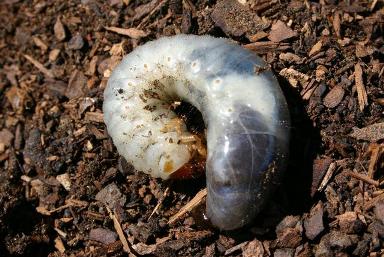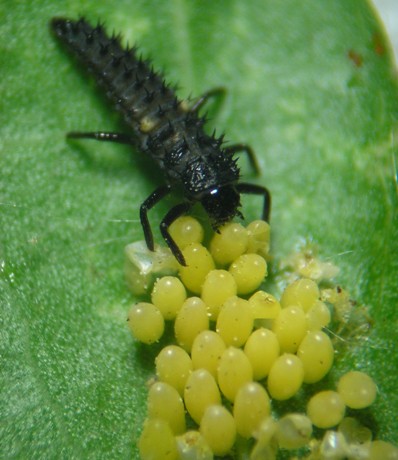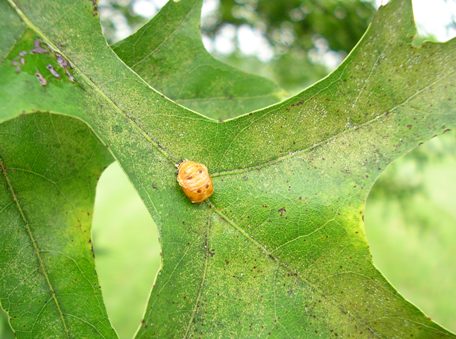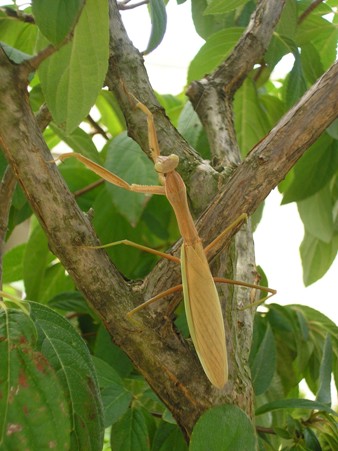IDENTIFYING INSECTS
Proper identification is important when applying pesticides to lawns, trees, shrubs, and flowers. Some insects should be eliminated while others are best just left alone. There are the good, the bad, and the ugly. The good will eat the bad and the ugly will result in unsightly plants but are not at risk of doing any real harm. They will leave after finishing their business.
LAWN DAMAGING INSECTS
GRUBS

 All lawns have the chance of falling victim to grubs. Grubs are the larvae of a variety of beetles, including Japanese beetles and May and June beetles. They feast on the grass roots underground, often going unnoticed until the grass dies and must be replaced. Heavier infestations may take place near rose bushes, plum trees, and other plants highly favored by beetles.
All lawns have the chance of falling victim to grubs. Grubs are the larvae of a variety of beetles, including Japanese beetles and May and June beetles. They feast on the grass roots underground, often going unnoticed until the grass dies and must be replaced. Heavier infestations may take place near rose bushes, plum trees, and other plants highly favored by beetles.

 If you suspect you have grubs, gently pull up on the sod in the suspected area. In areas of heavy infestation, the sod will lift like a rug. Treat the entire lawn immediately and repair any damage.
If you suspect you have grubs, gently pull up on the sod in the suspected area. In areas of heavy infestation, the sod will lift like a rug. Treat the entire lawn immediately and repair any damage.
Other common lawn insects include the sod webworm and chinch bug.
GOOD INSECTS
YELLOW GARDEN SPIDER

 The yellow garden spider is a friend in the garden. They eat insects up to two times their size. A yellow garden spider may bite a human in defense but is otherwise harmless. Allow them to reside in your garden. In return they will eliminate bad insects at no cost.
The yellow garden spider is a friend in the garden. They eat insects up to two times their size. A yellow garden spider may bite a human in defense but is otherwise harmless. Allow them to reside in your garden. In return they will eliminate bad insects at no cost.
LADY BUG

 Another friend in the garden is the lady bug. The lady bug will feed on garden pests like aphids, mites, and scale insects. Typically eggs will be laid near their prey. This allows the larvae to find food easily upon hatching.
Another friend in the garden is the lady bug. The lady bug will feed on garden pests like aphids, mites, and scale insects. Typically eggs will be laid near their prey. This allows the larvae to find food easily upon hatching.
Three pictures are provided, showing various life stages: the adult with eggs, the larvae with eggs, and the pupal.

 Lady bugs overwinter on objects or sometimes in structures during the winter months. They will then be one of the first insects seen as spring approaches. Eggs hatch in about 3 to 4 days. Clusters will vary but may include several dozen eggs. The larvae will then pass through a two week period after which the pupal stage occurs. After several more days an adult ladybug is reproductive and ready to start a family.
Lady bugs overwinter on objects or sometimes in structures during the winter months. They will then be one of the first insects seen as spring approaches. Eggs hatch in about 3 to 4 days. Clusters will vary but may include several dozen eggs. The larvae will then pass through a two week period after which the pupal stage occurs. After several more days an adult ladybug is reproductive and ready to start a family.

 While the lady bug is typically a friend, some species have become a nuisance. For example the Asian lady beetle's habit of overwintering in structures, has led to it becoming an indoor pest.
While the lady bug is typically a friend, some species have become a nuisance. For example the Asian lady beetle's habit of overwintering in structures, has led to it becoming an indoor pest.
PRAYING MANTIS

 The praying mantis received its name because of the common prayer like stance. They are predatory and enjoy a balanced diet of insects. Using their skill of camouflage, they are protected from their predators as they await a victim.
The praying mantis received its name because of the common prayer like stance. They are predatory and enjoy a balanced diet of insects. Using their skill of camouflage, they are protected from their predators as they await a victim.

 The praying mantis will go through three stages: the egg, nymph, and adult. The mass of eggs is often attached to a surface, wrapped around plant life, or placed in the ground. The nymph is similar to the adult, except it lacks wings and the ability to reproduce. The nymph will molt several times before the final molt where wings are present. A few species are wingless or will have wings shorter than most.
The praying mantis will go through three stages: the egg, nymph, and adult. The mass of eggs is often attached to a surface, wrapped around plant life, or placed in the ground. The nymph is similar to the adult, except it lacks wings and the ability to reproduce. The nymph will molt several times before the final molt where wings are present. A few species are wingless or will have wings shorter than most.

 While a mantis will prey on insects harmful to the garden, it should be known that they enjoy eating both the good and the bad.
While a mantis will prey on insects harmful to the garden, it should be known that they enjoy eating both the good and the bad.
